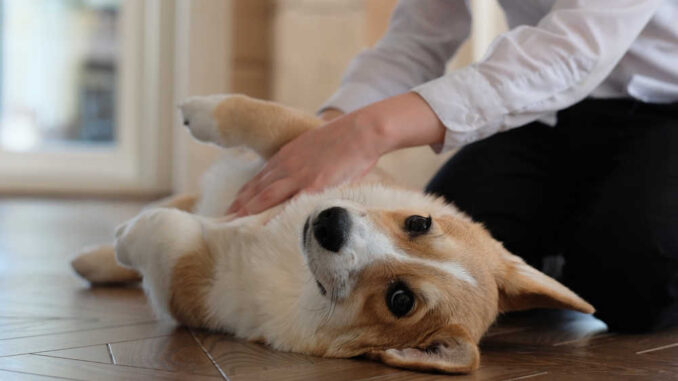
This article was updated on December 7th, 2023

Dogs can have many skin issues like lumps, bumps or brown spots. As a veterinarian, I see these skin problems on a daily basis. This article will focus on brown spots on dog skin, their meaning, and if treatment is necessary.
Key highlights:
– Reasons for brown spots on dog skin can be wide-ranging, including aging, sun exposure, injuries, and cancer.
– Call your vet if you notice sudden changes in size, shape, texture, or color.
– Gradual development of spots over time are normally nothing to be concerned about (as long as the dog is not showing signs of discomfort or illness).
– Consult your vet if your dog is uncomfortable or behaving differently.
4 Things You Should Know About Brown Spots on Dog Skin
Brown spots on dog skin can appear for many different reasons from simple age spots to skin infections, sun exposure or even cancer. In this article, our veterinarian Dr. Chyrle Bonk shares 4 things you should know:
1. Gradual skin changes are usually nothing to worry about
As a dog ages, their body goes through all kinds of changes, their skin included. One of those changes that you may see is the development of age spots. These brown spots are typically harmless, as shown on the picture below:
Picture of normal brown spots:
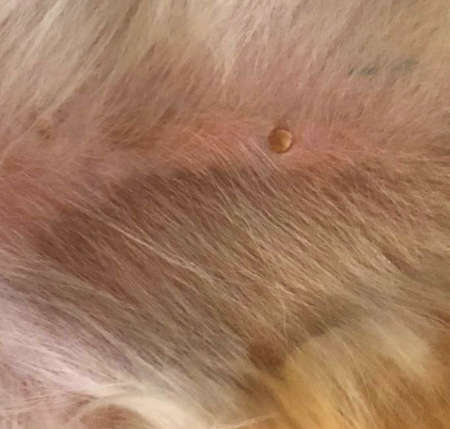
Brown spots on a dog’s skin can also be caused by simple things like sun exposure or even new medications. If your furry friend has recently started a new medication or gradually developed dark spots over time due to aging, there’s likely no need to worry.
“If you notice new darker spots on your dog that don’t seem to be bothering them, you may choose to watch and monitor for a few weeks to see if anything changes.”
Pictures of normal brown spots:

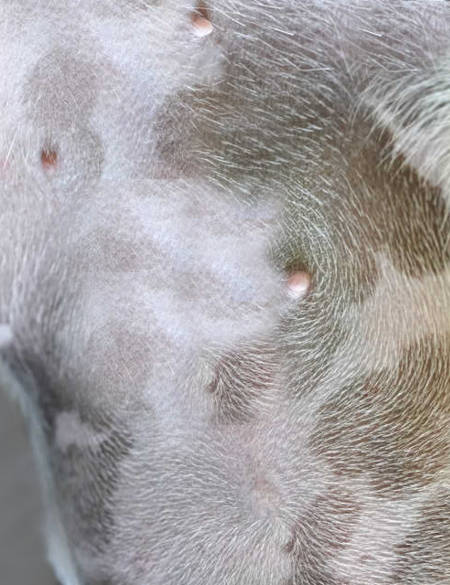
Just be sure to keep an eye on these new spots for any sudden changes in size, shape, texture, or color. See your veterinarian if you’re at all concerned, if you see any changes, or if your dog is showing signs of discomfort or illness.
2. Call your vet if the brown spots change in appearance or make your dog uncomfortable
Changes in your dog’s skin can be tricky to deal with. This is why it’s so important to consult your veterinarian anytime anything new pops up. This is especially important with new lumps, bumps, and spots. Call your vet if you see any of the following:
- The brown spot happens to grow
- The brown spot changes in shape, texture, or color
- Your dog is showing signs of discomfort or illness (e.g. itchiness, red skin, etc)
- Your dog behaves differently (changes in appetite, behavior, or activity level that may indicate that something is off with your pup)
Example pictures of problematic brown spots:
Here are several pictures showing brown spots along with other worrisome symptoms such as red skin, changes in skin texture (like scabs), hair loss, or itchiness. These symptoms are typically the sign of an underlying medical condition such as allergies or skin infections.
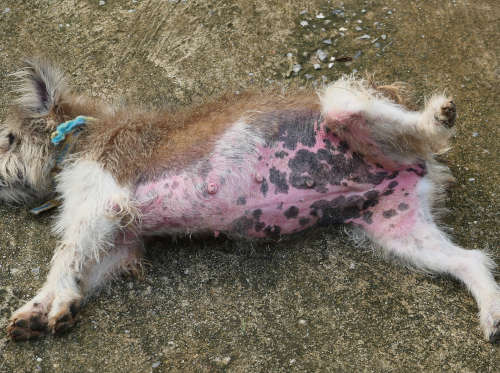
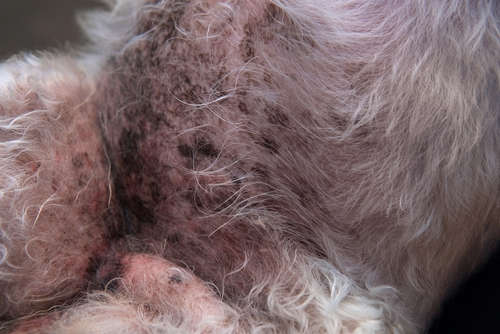
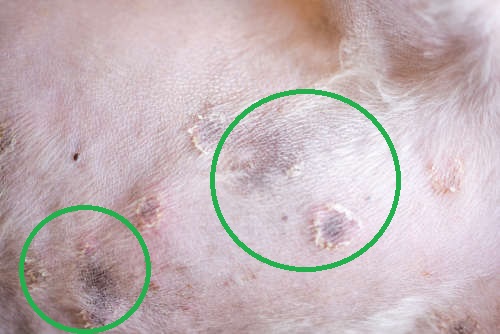
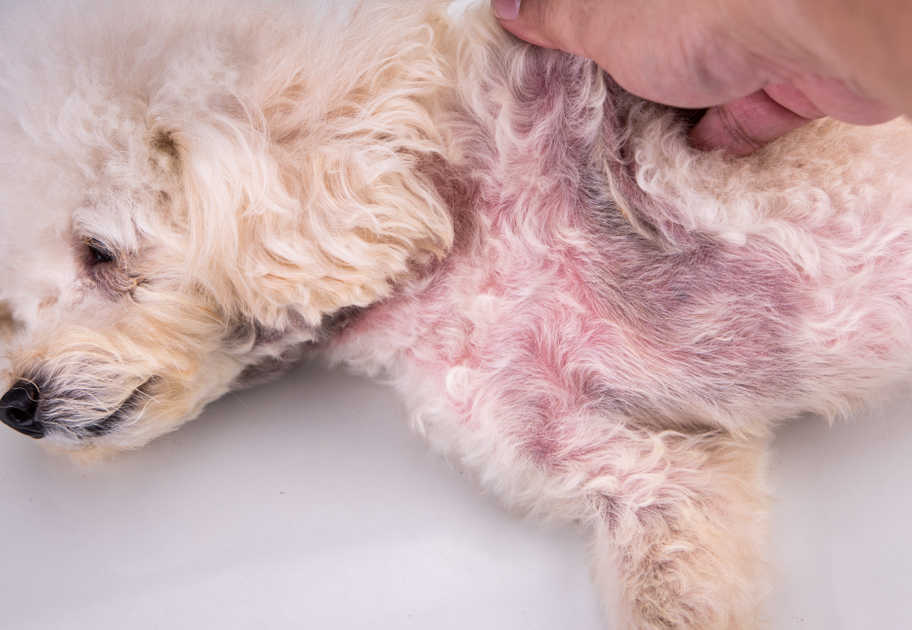
3. There are many common causes of brown spots on dog skin
Let’s take a look at some of the major causes:
1. Natural freckles
If your pup has more than one color to their haircoat, their skin will also have more than one color. Lots of different colored spots, or dapples, mean that the skin underneath can also be spotted. This makes for natural dark spots that you may notice when you part the hair.
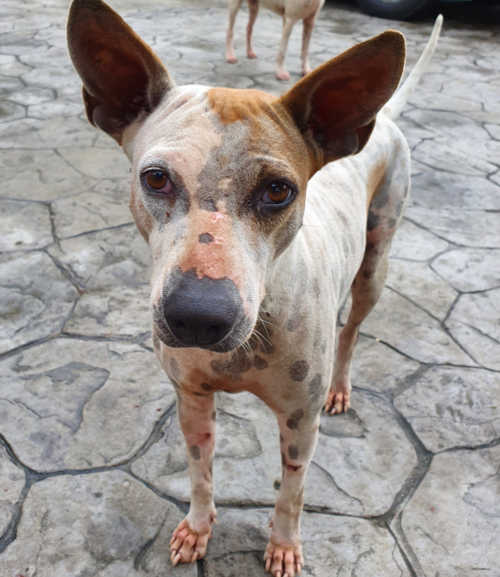
This will, of course, show up more commonly in spotted dogs, such as Dalmatians, Australian Shepherds, and Dachshunds, but can show up in any breed of any color. The dark spots won’t change over time, and your pup won’t even notice they have them. As long as these spots have been there during your dog’s entire life, no treatment is necessary.
2. Sun exposure
Just like people that seem to pop up with new freckles every time the sun shines, some dogs may develop brown spots on their skin after being out in the direct sun. This is because sunlight can encourage the production of more melanin. These spots will likely show up in the lightly-haired areas of the body. They may also be associated with sunburns and can turn cancerous.
If you notice new brown or black spots on your dog’s light skin, see your veterinarian. This is especially important if those spots are growing, changing shape, or if your dog is bothered by them.
3. Hyperpigmentation
Hyperpigmentation is the darkening and thickening of the skin as a dog’s body reacts to different things:
- Inflammation
- Chronic irritation
- Hormones
- Infections
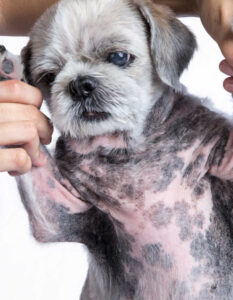
Obesity is even a culprit as excess fat rolls rubbing together create irritation that can turn the skin dark. This will show up as dark spots in the affected area. You may also see redness around the edges, a thickening and hardening of the skin, and possibly some itching or licking. Learn more about hyperpigmentation.
“Have your veterinarian check out any changes to your dog’s skin color. Since some of the causes of hyperpigmentation can be quite serious, you’ll want to seek professional treatment.”
4. Skin infections
One of the causes of hyperpigmentation, and therefore, brown spots, is a skin infection. Whether of the fungal, bacterial, or parasitic variety, these infections can cause inflammation that could lead to color changes in the skin.
With skin infections, you will likely see other signs: dogs may be itchy, have redness bordering the brown spots, and their skin may develop an odor.
Pictures of spots due to infections:

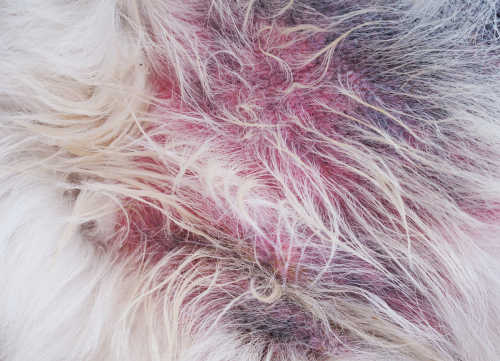
Dogs with skin infections often display clinical signs such as itching, redness, inflammation, hair loss, or scabs. They may also exhibit discomfort and restlessness.
Your veterinarian will need to look at your dog’s skin and possibly take skin scrapings to look at under the microscope to determine the cause of your dog’s skin infection. Medications, such as antibiotics, antifungals, and parasiticides, will be used to treat.
Learn more about skin infections in dogs (with pictures and veterinarian advice).
5. Skin allergies
Another cause behind changing skin color in dogs is allergies. Just like humans, our pups are susceptible to all kinds of allergies. Some of those can cause chronic irritation of the skin that may lead to brown spots, as shown on the image below:

Skin allergies may be due to contacting an allergen in the environment or something they ate. Either way, you may see itching and redness with those brown spots.
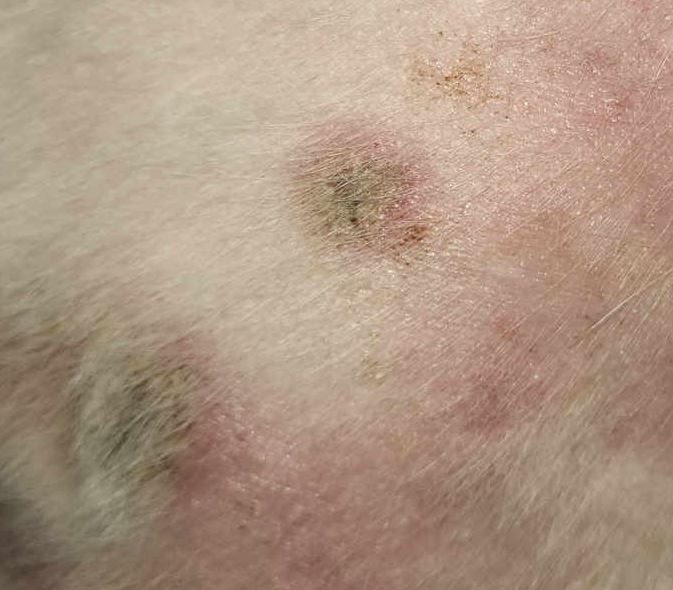
Itchy, allergy skin usually shows up on feet, ears, or lightly-haired areas of the body like the belly and groin. Your vet will want to take a skin scraping to rule out other causes of your dog’s changing skin color. They will then try to treat by removing the allergen or by using topical or oral antihistamines or anti-inflammatories.
Learn more about skin allergy issues.
6. Cancer
Most pet parents who see a new brown spot on their dog’s skin will immediately jump to the diagnosis of cancer—and with good reason. Melanomas and other skin cancers are the most commonly diagnosed malignant tumors in dogs. But that doesn’t mean that every new brown spot is indeed cancer.
Any sudden color change in your dog’s skin should be seen by a veterinarian solely because it could mean cancer. The most common type of cancer that causes dark spots or lumps on the skin is melanoma. This can be a very aggressive type of cancer, and so any new spots should be checked out as soon as possible, especially if the spot grows or changes in shape or texture.
These spots may show up anywhere on your dog’s body but look for them more commonly in lighter-haired parts as well as inside the mouth, as shown on the picture below:
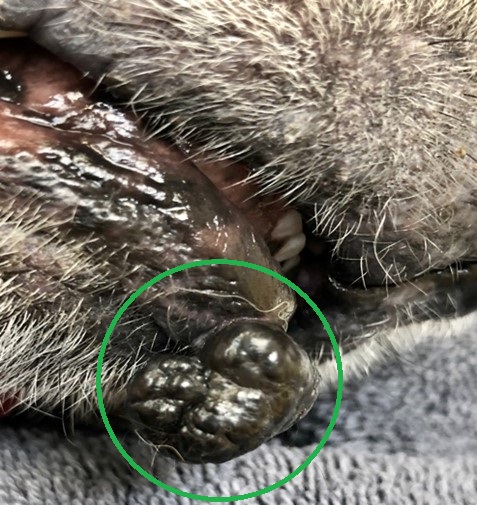
“Because cancers can spread to organs such as the lungs, liver, and spleen, it is imperative to diagnose and treat them as soon as possible.”
7. Medications and other causes
Whole-body health conditions, such as hypothyroidism, Cushing’s, and diabetes, can all result in dark or brown spots on the skin. You may also notice hair loss, a change in appetite and water consumption, and increased urination. Moreover, some medications, such as antifungals, may lead to a color change in the skin.
Your vet will want to run bloodwork and other tests if you notice any of these changes. Most of these issues that cause brown spots can be treated with medications, which are often lifelong.
Melanin Is Responsible for Changing Skin Color
Changes in skin color are usually due to a change in the skin pigment. Dark coloring is due to pigmentation called melanin. The more melanin a dog has, the darker their skin and hair. Sometimes that melanin can clump into a group and create a dark spot.
Vet Diagnosis Can Involve Skin Scrapes and Biopsy
The diagnostics for nearly every skin issue in dogs is going to involve a sample. This may be a skin scraping, fine needle aspirate, or even a biopsy of the brown spot in order to see what’s going on with your dog’s skin. Look to spend about $100-$300 for diagnostics.
“To be on the safe side, see your veterinarian anytime your dog shows up with changes on their skin for a proper diagnosis and to start treatment, if necessary, as soon as possible.”
Related posts:
Black Spots on Your Dog’s Skin
Disclaimer: This website's content is not a substitute for veterinary care. Always consult with your veterinarian for healthcare decisions. Read More.



Be the first to comment